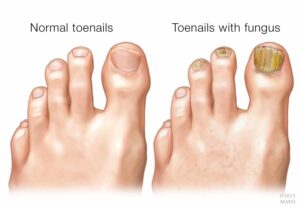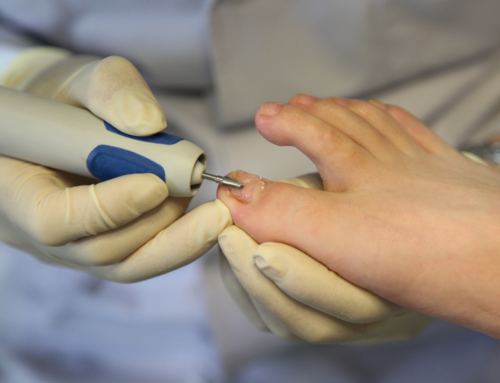Can toenail fungus spread to family member? Yes you can spread a toenail fungus infection to your family members. It important to seek treatment if you believe you have a. toenail fungus infection.
Why does my family have toenail fungus infections?
If multiple members of your family have toenail fungus, it doesn’t necessarily mean the condition is inherited. Toenail fungus itself is not genetic, but the risk factors that make someone more susceptible can run in families. Things like naturally sweaty feet, slower nail growth, flat feet, or a weaker immune response can be shared traits. This makes it easier for the fungus to take hold when someone is exposed.
More commonly, toenail fungus spreads in families simply because everyone shares the same environment. Fungus thrives in warm, damp places, and it can linger on bathroom floors, in showers, inside shoes, and even on nail clippers. When one person develops a fungal infection, it’s easy for others in the household to come into contact with the same fungal spores and become infected as well. This is especially true if someone has athlete’s foot, which often spreads to the nails over time.
Types of Toenail Fungus Infections
Toenail fungus, or onychomycosis, can develop in several different forms. This depends on the type of fungus involved and how the infection spreads through the nail. The first and most common type is distal subungual onychomycosis. It occurs when dermatophyte fungi invade the nail bed from the tip or sides of the nail. This form typically begins with a yellow or white spot near the edge of the nail. It then gradually spreads inward, causing the nail to thicken, discolor, and crumble at the edges. Because it affects the underside of the nail, it can be difficult to treat and often requires long-term therapy.
The second type, known as white superficial onychomycosis, is caused by fungi that attack only the surface of the nail plate. This results in white, chalky patches on the nail’s surface that can often be scraped away. It tends to progress more slowly. It is usually easier to treat since the infection does not penetrate deeply into the nail.
A third and less common form is proximal subungual onychomycosis, which begins at the base of the nail near the cuticle and spreads upward as the nail grows. This type is often associated with weakened immune systems. It is also associated with other underlying health conditions and may signal a more serious systemic issue.
A fourth and rare form, candida onychomycosis, is caused by yeast rather than dermatophyte fungi. It typically affects fingernails more than toenails. It causes swelling, redness, or even separation of the nail from the nail bed.
Finally, the fifth type is a total dystrophic onychomycosis is considered the end stage of long-standing infection. The nail becomes completely discolored, thickened, and deformed. Recognizing the specific type of toenail fungus is important because it helps determine the most effective treatment. Whether it is topical, oral, or laser-based, it improves the likelihood of achieving clear, healthy nails.

Symptoms of Toenail Fungus
Toenail fungus is not always immediately noticeable, but there are several symptoms to watch out for, including the following:
- Thickened, brittle, or distorted nails
- Yellow or white discoloration of the nails
- Flaky toenails
- Separation of the nail from the nail bed
- A foul odor emanates from the affected nails
- Cracked or peeling nails
- Pain or discomfort, especially when walking or wearing shoes
If you notice these symptoms, it’s essential to schedule a consultation with a doctor, preferably a podiatrist. This way, you may receive a proper diagnosis and treatment plan. Early detection and intervention can prevent the infection from spreading and becoming more difficult to treat.
Preventing Toenail Fungus
Even after successful treatment, prevention is key:
- Dry your feet thoroughly after bathing or swimming
- Wipe between your toes and allow the shoes to air out
- Wear flip-flops in public showers or pool areas
- Avoid sharing shoes, socks, or towels
- Choose breathable footwear
- Maintain proper nail hygiene and trim nails regularly
- Use post-treatment care as recommended by our foot doctors
By keeping your feet clean and dry and practicing these habits, you can reduce the risk of reinfection
Laser Toenail Fungus Treatment
If you have caught nail fungus, it can be easily treated using the FDA-approved PinPointe laser, which typically only takes one treatment. Other treatments, like topical solutions and oral medication, are not as effective. Topical solutions have a very low cure rate. This is because the solution does not penetrate all the way through the nail bed. Oral medication has a higher cure rate than topicals, but our nail doctors do not recommend it. This is because it can lead to liver toxicity. You would need to have consistent blood tests throughout the course of taking the medication.
Our nail doctors recommends this treatment for toenail fungus. The PinPointe Laser treatment has the highest cure rate in the market. It has no side effects and no recovery period. As a result, you can go about your daily activities right after the treatment. Also, there’s no pain.
If you have any signs of nail fungus, call us at 800-672-0625 or visit our website for more information on our doctors at one of our over 150 locations.






